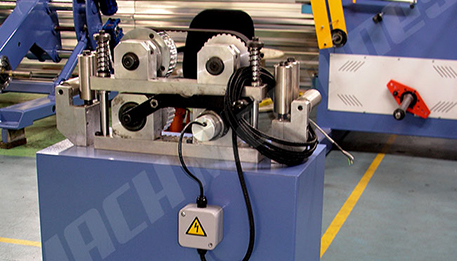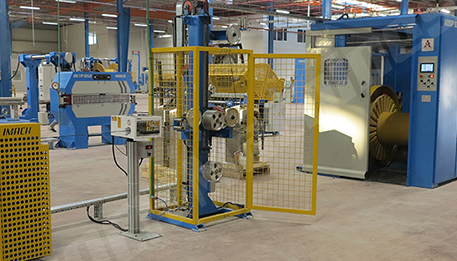welcome to?
Aymak Makine?
Top Quality Machines to produce Cable?








































History?

Aymak Makine Ltd. operates in the sector of machinery production for cable industry. We are one of the biggest cable machinery producer in TURKEY. Our extensive knowledge gained in the sector over 30 years, the company improves it further by current technology and expert staff every day. Basing on an understanding of Total Quality and Customer Satisfaction, our company is certificated by the certificate of quality to the standard ISO EN 9001:2008.?
With strict control over all machines and lines it has produced from the very establishment of the company throughout all phases from design to operation, our company constantly enhance and improve customer satisfaction with respect to timely delivery and service, making the trademark IMACH® a shining star.?
Managing and producing completely in its own body from offer to delivery, our company aims at meeting expectations of its customers, employees, shareholders and society, safeguarding the environment in which it operates, ensuring use of the natural resources efficiently, keeping it as its principle to improve constantly, enhancing total quality level through training with consistent quality targets, following up all technological developments to increase its competitive power under the hanging market condition be become a preferred company in the sector.?
We are committed to make you satisfied.?
Quality Policy?

Aymak Makine Ltd. which has identified its quality with the principle of customer satisfaction with its experiences since its establishment, will continue to progress confidently towards becoming a wanted brand by following the technological developments closely and expanding its domestic and foreign trade capacity.?
We are committed to continuous improvement by recognizing that the main factor is the appropriate human investment with the value we give to our personnel, ensuring the participation and satisfaction of all employees with continuous training and complying with the requirements of the ISO 9001: 2015 Quality Management System in line with ISO 9001 Quality Management System.?
With production of our top quality machines, we will never leave the line of being an exemplary organization that always prioritizes the customer's appreciation above all without compromising its quality.?
Aymak Makine?
Müh. Hiz. San. ve Tic . Ltd. Şti.?
Address?
Aydınlı Mah. Birlik OSB.?
Batı Cad. No:12 Tuzla?
34953,? İstanbul / TÜRKİYE?
+90 216 622 3281?
+90 216 620 9786?
[email protected]?
Single Mono Wire Production Flow?
- Supplying of Copper Rod?
- Drawing & Annealing?
- Supplying of Insulation Material?
- Insulation?
- Coiling and Packing?
Multiple Mono Wire Production Flow?
- Supplying of Copper Rod?
- Drawing & Annealing?
- Stranding or Twisting?
- Supplying of Insulation Material?
- Insulation?
- Coiling and Packing?
Flexible Wire Production Flow?
- Supplying of Copper Rod?
- Drawing & Annealing?
- Stranding or Twisting?
- Supplying of Insulation Material?
- Insulation?
- Coiling and Packing?
Power Cable Production Flow?
- Supplying of Copper Rod?
- Drawing & Annealing?
- 7 to 61 Wires Stranding?
- Supplying of Insulation Material?
- Insulation of core?
- Laying-up required number of cores?
- Out Layer Sheeting?
- Coiling and Packing?
Armored Cable Production Flow?
- Supplying of Copper Rod?
- Drawing & Annealing?
- Stranding and Shaping?
- Supplying of Insulation Material?
- Insulation of core?
- Laying-up required number of cores?
- Inner Layer Sheeting?
- Armoring with Steel Wires?
- Out Layer Sheeting?
- Packing?

What is
Insulation?
Insulation is a nonconductive material, or a material resistant to the flow of electric current.It is often called a dielectric in radio frequency cables. Insulation resists electrical leakage, prevents the wire’s current from coming into contact with other conductors and preserves the material integrity of the wire by protecting against environmental threats such as water and heat. The safety and effectiveness of the wire depend on its insulation.
Read More?Extruders?
|
Operations : Insulation, Isolation, Jacketing, Filling ? |
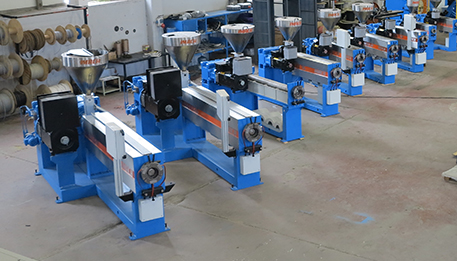



| Screw Dia. [mm]? | Output (PVC) [kg]? | Power [kW]? | Screw Rpm? | Heating Zones? | Heating Power [kW]? | Screw Length? | Compounds? | Optional Equipments? | Safety Regulation? | System Voltage? |
|---|---|---|---|---|---|---|---|---|---|---|
| 35 | 50 | 7,5 | 200 | 2 | 3,6 | 20-30D | PVC, PP, XLPE, PA, PE (LDPE, HDPE), TPU, TPE, HFFR, LSF, LSF-HFFR |
Mobility Stand? - Quick Color Change? - Hopper Loader? - Granule Dryer? - Masterbatch Dosing Unit? - Melt Pressure Transmitter? - Screw Heat Control System? |
CE | 380V 50Hz 460V 60Hz |
| 45 | 80 | 22 | 200 | 3 | 5,4 | |||||
| 60 | 250 | 45 | 150 | 3 | 9,8 | |||||
| 75 | 350 | 71 | 100 | 4 | 13,2 | |||||
| 90 | 450 | 110 | 100 | 4 | 18,7 | |||||
| 100 | 550 | 110 | 100 | 4 | 20,5 | |||||
| 120 | 800 | 200 | 80 | 5 | 31,4 |
Crossheads?
|
Operations : Insulation, Isolation, Jacketing, Filling ? |





| Crosshead Size? | Min. Input Dia. [mm]? | Max. Input Dia. [mm]? | Min. Output Dia. [mm]? | Max. Output Dia. [mm]? | Crosshead Types? | Tool Types? | Materials? | Optional Equipments? |
|---|---|---|---|---|---|---|---|---|
| 6 | 0,9 | 4 | 2 | 6 |
Fixed Center? - Manuel Center? |
Press, Semi-Press, Tube? |
PVC, PP, XLPE, PA, TPE (LDPE, HDPE), TPU TPE, HFFR, LSF, TLSF-HFFR, SILICONE |
Mobility Stand? |
| 15 | 1,5 | 12 | 3 | 15 | ||||
| 30 | 4 | 21 | 6 | 30 | ||||
| 50 | 6 | 44 | 8 | 50 | ||||
| 80 | 17 | 70 | 20 | 80 | ||||
| 100 | 17 | 90 | 20 | 100 |
Cooling Throughs?
|
Operations : Insulation, Isolation, Jacketing, Filling ? |





| Material? | Construction Types? | Optional Equipments? | Safety Regulation? | System Voltage? |
|---|---|---|---|---|
| Stainless Steel? |
Multi Pass? Single Pass? |
Active Capstan? - Pneaumatic Door Lift? - Warm Water Section? - Drying Unit? |
CE | 380V 50Hz 460V 60Hz |
Insulation Lines?






What is
Stranding?
Cables for fixed installation in wire channels or long walls or long sealings of rooms need to be bendable. Cores for moveable electric devices and units need to be flexible. The required processability is achieved by using stranded conductors inside the cable which are produced on stranding machines.
Read More?Double Twist Bunchers?
|
Operations : Bunching, Stranding, Tape Application ? |





| Reel Size [mm]? | Max. Rpm? | Max. Twist? | Max. Line Speed [m/min]? | Optional Equipments? | Safety Regulation? | System Voltage? |
|---|---|---|---|---|---|---|
| 630 | 2500 | 5000 | 200 |
Automatic Lubrication System? - Reel Measuring System? - Vibration Detecting System? |
CE | 380V 50Hz 460V 60Hz |
| 800 | 2000 | 4000 | ||||
| 1000 | 1000 | 2000 | ||||
| 1250 | 900 | 1800 | ||||
| 1600 | 400 | 800 | ||||
| 2000 | 400 | 800 |
Single Twist Bunchers?
|
Operations : Bunching, Stranding, Tape Application ? |





| Reel Size [mm]? | Max. Rpm? | Max. Line Speed [m/min]? | Optional Equipments? | Safety Regulation | System Voltage |
|---|---|---|---|---|---|
| 630 | 1000 | 150 |
Automatic Lubrication System - Reel Measuring System |
CE | 380V 50Hz 460V 60Hz |
| 800 | 750 | ||||
| 1000 | 400 | ||||
| 1250 | 300 | ||||
| 1600 | 250 | ||||
| 2000 | 150 |
Rigid Stranders?
|
Operations : Stranding, Armoring, Screening ? |





| 400 | 500 | 630 | Max. Line Speed? | Inlet Wire Diameter? | Optional Equipments? | Safety Regulation? | |||
|---|---|---|---|---|---|---|---|---|---|
| Reel Quantity? | Max. Rpm (Cu/Al)? | Reel Quantity? | Max. Rpm (Cu/Al)? | Reel Quantity? | Max. Rpm (Cu/Al)? | ||||
| 6 | 300 / 350 | 6 | 240 / 300 | 6 | 200 / 250 | 50 |
Copper? 1,5-3,6 Aluminum? 1,75-5,0 |
Automatic Reel Loading System? - Sector Shaping Attachments? |
CE |
| 12 | 250 / 270 | 12 | 200 / 150 | 12 | 180 / 220 | ||||
| 18 | 200 /220 | 18 | 160 / 200 | 18 | 140 / 170 | ||||
| 24 | 180 / 200 | 24 | 125 / 150 | 24 | 110 / 130 | ||||
| 30 | 140 / 160 | 30 | 100 / 120 | 30 | 90 / 100 | ||||
| 36 | 110 / 130 | 36 | 80 / 100 | 36 | 70 / 80 | ||||
Planetary Stranders?
|
Operations : Stranding, Armoring, Screening ? |
|
Sectors : Aerospace, Control Cables, Infrastructure, Oil&Gas, Renewable Energy ? |





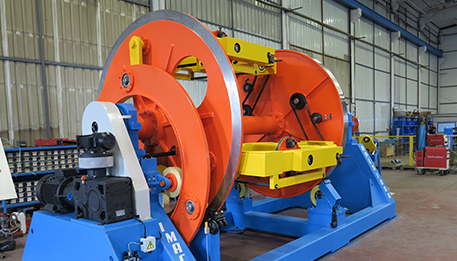




| Reel Diameter? | Max. Rpm? | Optional Equipments? | Safety Regulation? | System Voltage? |
|---|---|---|---|---|
| 500 to 1600? | 150 |
Automatic Lubrication System? - Pneaumatic Brake System? - Electromagnetic Brake System? - Mechanical Brake System? - Load Cell Tension Adjusting System? |
CE |
380V 50Hz 400V 60Hz |
Skip (Bow) Stranders?
|
Operations : Stranding ? |
|
Applications: Copper and Aluminum Wire, MV&HV Cables, Wire and Cable Stranding ? |





| Reel Diameter? | Max. Rpm? | Reel Quantity? | Max. Diameter [mm]? | Optional Equipments? | Safety Regulation? | System Voltage? |
|---|---|---|---|---|---|---|
| 630 to 1600? | 1000 - 300 | 1+3 / 1+6 | 60 |
Automatic Lubrication System? - Pneaumatic Brake System? - Electromagnetic Brake System? - Mechanical Brake System? |
CE |
380V 50Hz 400V 60Hz |
Rotating Payoffs - Take Ups?
|
Operations : Stranding, Armoring, Screening, Laying Up ? |
|
Sectors : Control Cables, Infrastructure, Renewable Energy ? |





| Reel Size? | Reel Weight [Ton]? | Max. Rpm? | Max. Line Speed? | Optional Equipments? | Safety Regulation? | System Voltage? |
|---|---|---|---|---|---|---|
| 1250 | 3 | 180 | 100 |
Loading Platform? - Sector Stranding? |
CE |
380V 50Hz 400V 60Hz |
| 1600 | 6 | 150 | ||||
| 2000 | 8 | 120 | ||||
| 2240 | 12 | 90 | ||||
| 2600 | 20 | 75 | ||||
| 3000 | 25 | 50 | ||||
| 3200 | 30 | 50 |
Stranding Lines?



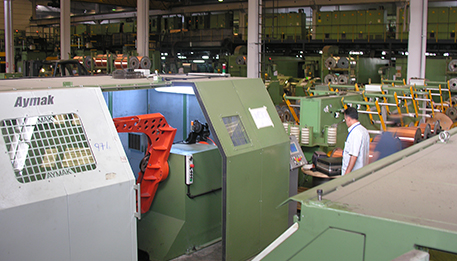




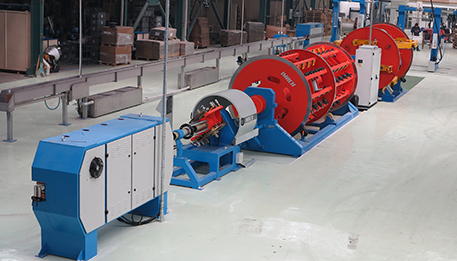


What is
Spooling?
Cores, cables or fillers need to be transported between machines, lines or processes. Spooling machines and rewinding lines are, used to wind products around reels to fill suitable size drums for cable production machines.
In the other hand, spooling machines and rewinding lines are used to feed production lines with feedstock and winding finished product around output reel. Also can be used to wind around selling drums on demand to deliver products to end user.
Flyer Payoffs?
Unwinding, Payoff?





| Reel Size? | Max. Reel Weight? | Conductor Crossection? | Insulated Crossection? | Max. Line Speed? | Optional Equipments? | Safety Regulation? | System Voltage? |
|---|---|---|---|---|---|---|---|
| 500-630 | 600 | 0,75 - 6,0 | 1,0-4,0 |
Passive? 400 Active? 1200 |
Motorized Lift? - Hydraulic Manuel Lift? |
CE | 380V 50Hz 460V 60Hz |
| 630-800 | 1000 | 0,75 - 6,0 | 1,5-6,0 |
Passive? 300 Active? 1000 |
|||
| 800-1000 | 1200 | - | 2,5-6,0 |
Passive? 250 Active? 600 |
|||
| 1000-1250 | 2000 | - | 4,0-6,0 |
Passive? 200 Active? 400 |
Multi Wire Payoffs?
Unwinding, Payoff?





| Reel Diameter? | Reel Weight? | Reel Quantity? | Max. Line Speed? | Optional Equipments? | Safety Regulation? | System Voltage? |
|---|---|---|---|---|---|---|
| 630-800 | 700-1100 | 1-12 | 50-600 | Reel Loading Trolley? | CE | 380V 50Hz 460V 60Hz |
Backtwist Payoffs for Pairing?
Unwinding, Payoff, CAT 6, CAT 5?





| Reel Diameter? | Reel Quantity? | Max. Line Speed? | Backtwist Ratio? | Safety Regulation? | System Voltage? |
|---|---|---|---|---|---|
| 400, 500, 630 | 2, 4 | 60 | 0%-100% Adjustable? | CE | 380V 50Hz 460V 60Hz |
Double Spooler?
Winding, Takeup?





| Reel Diameter? | Reel Quantity? | Non-Stop Works? | Max. Line Speed? | Safety Regulation? | System Voltage? |
|---|---|---|---|---|---|
| 400 - 1600 | 2 | Yes? | 300-1800 | CE | 380V 50Hz 460V 60Hz |
High Speed Payoff and Takeup?
Winding, Takeup, Unwinding, Payoff?





| Reel Diameter | Max. Line Speed | Safety Regulation | System Voltage |
|---|---|---|---|
| 400 - 1000 | 300 - 1200 | CE | 380V 50Hz 460V 60Hz |
Fork Type Payoffs and Takeups?
Winding, Takeup, Unwinding, Payoff?





| Reel Diameter? | Max. Line Speed? | Safety Regulation? | System Voltage? |
|---|---|---|---|
| 400 - 1600 | up to 800? | CE | 380V 50Hz 460V 60Hz |
H Type Payoffs and Takeups?
Winding, Takeup, Unwinding, Payoff?





| Reel Diameter? | Max. Line Speed? | Safety Regulation? | System Voltage? |
|---|---|---|---|
| 400 - 1250 | 800 | CE | 380V 50Hz 460V 60Hz |
Portal Payoffs and Takeups?
Winding, Takeup, Unwinding, Payoff?





| Reel Diameter? | Reel Weight [Ton]? | Safety Regulation? | System Voltage? |
|---|---|---|---|
| 1800 - 4500 | 4 - 50 | CE | 380V 50Hz 460V 60Hz |
Rewinding Lines?




What is
Taping?
Tape insulation and jacketing provide important layers of mechanical and electrical protection for a cable. Choosing the appropriate materials for each can be an important decision.
Read More?Tangential Taping Machine?
|
Operations : Taping, Armoring ? |





Concentric Taping Machine?
|
Operations : Taping ? |





Simple Tape Payoff?
|
Operations : Taping Unwinding? |

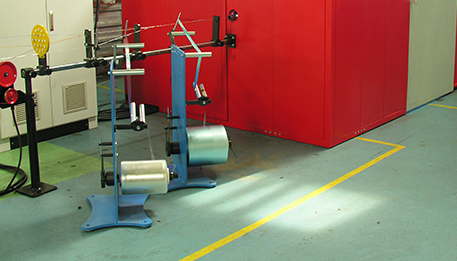
Active Tape Payoff?
|
Operations : Taping Unwinding? |




What is
Armoring?
Armor is a metal layer wrapped around the exterior of a cable to provide mechanical protection. It is primarily used in hazardous environments that require an extra layer of cable defense, or in situations where Type MC (metal clad) cable is required by the National Electric Code.
Read More?Tangential Taping Machine?
|
Operations : Taping, Armoring ? |





Rigid Armoring?
|
Operations : Stranding, Armoring, Screening? |





| Reel Quantity? | Max. Rpm? | Reel Diameter [mm]? | Max. Line Speed? | Optional Equipments? | Safety Regulation? | System Voltage? |
|---|---|---|---|---|---|---|
| 24 | 200 | 400 | 50 | Preformer | CE | 380V 50Hz 460V 60Hz |
| 36 | 150 | |||||
| 48 | 120 | |||||
| 72 | 100 |
Armoring Lines?

What is
Coiling?
A coiling or coil is a curve, used for storing cable in compact and reliable yet easily portable form in lengths specified in standards. Coiling process is one of the critical operation in cable production steps cause of effects directly the loses. Length measuring must be done preciously on coiling machines and lines. Shape of coils are also important for end user, coil quality makes the day on from perspective of labour time.
Basic Selling Forms
- Drums
(Packing on production lines) - Spools
(Packing on reel coiling machines) - Coils
(Packing on coiling machines)
Wooden Reel Coiling Machine?
Coiling?





| Reel Diameter? | Max. Line Speed? | Optional Equipments? | Safety Regulation? | System Voltage? |
|---|---|---|---|---|
| Up to600? | 150 | Cable Cutter? | CE | 380V 50Hz 460V 60Hz |
Semi-Automatic Coiling Machine?
Coiling





| Coil Diameter? | Max. Speed? | Optional Equipments? | Safety Regulation? | System Voltage? |
|---|---|---|---|---|
| Up to 500? | 2 |
Active Traverse Attachment? - Cable Cutter? |
CE | 380V 50Hz 460V 60Hz |
Automatic Coiling Machine?
Coiling, Wrapping?





| Coil Diameter [mm]? | Crossections [mm²]? | Max. Speed [coil/min]? | Safety Regulation? | System Voltage? |
|---|---|---|---|---|
| 260 | 0,75 - 6 | 3 - 3,5 | CE | 380V 50Hz 460V 60Hz |
| 440 | 2x0,75 - 4x4 | 2 - 2,5 |
Coiling Lines?

What is
Insulation?
Insulation is a nonconductive material, or a material resistant to the flow of electric current.It is often called a dielectric in radio frequency cables. Insulation resists electrical leakage, prevents the wire’s current from coming into contact with other conductors and preserves the material integrity of the wire by protecting against environmental threats such as water and heat. The safety and effectiveness of the wire depend on its insulation.
PVC -A PVC jacket is a relatively inexpensive and easy-to-use material with the potential to be used in diverse applications. The maximum temperature range is minus 55 degrees Celsius to 105 degrees Celsius and is resistant to flame, moisture and abrasion. It also holds up against gasoline, ozone, acids and solvents. It can also be used for medical- and food-related purposes as it is odorless, tasteless and nontoxic. PVC jackets can be used in heavy- and thin-wall applications. PVC should not be used when flexibility and an extended flex life are required at low temperatures. When used in retractile cord applications, it also shows below-average flexibility. PVC jackets display high attenuation and capacitance loss, meaning that power is lost when used in an electrical system.
PE -This compound is used most in coaxial and low-capacitance cables because of its exemplary electric qualities. Many times, it is used in these applications because it is affordable and can be foamed to reduce the dielectric constant to 1.50, making it an attractive option for cables requiring high-speed transmission. Polyethylene can also be cross-linked to produce high resistance to cracking, cut-through, soldering, and solvents. Polyethylene can be used in temperatures ranging from negative 65 degrees Celsius to 80 degrees Celsius. All densities of polyethylene are stiff, hard and inflexible. The material is also flammable. Additives can be used to make it flame-retardant, but this will sacrifice the dielectric constant and increase power loss.
PP -This material is very similar to Polyethylene but has a wider temperature range of minus 30 degrees Celsius to 105 degrees Celsius. It is used primarily for thin-wall primary insulations. Polypropylene can be foamed to improve its electrical properties.
TPR -In many applications, TPR is used to replace true thermoset rubber. It has improved colorability, higher processing speeds and a wider usable temperature range. It also displays excellent heat, weather and age resistance without curing. TPR is not cut-through resistant but can be used in applications where other properties of rubber are preferred.
TPU -Thermoplastic polyurethane (TPU) is the go-to overmolding material for watertight applications or products that must survive harsh environments. Thermoplastic polyurethane also features good electrical insulation up to 1,000 V (exceeding the required 108 Ohm-cm by standard ISO6722).
The Difrence Between TPU and PVC
TPU, PVC is basically the same material, all thermoplastic elastomers, TPU is an alternative to PVC products. TPU is not plastic is resin. The advantages are oil resistance, cold resistance, anti-aging, and the performance is dozens of times that of PVC.
The English name TPU of thermoplastic polyurethane elastomer is a very excellent elastomer material. Compared with PVC material, there are mainly the following differences in appearance:
- Transparent TPU will have a yellow bottom after a long time. PVC generally has two types, blue and yellow.
- TPU hardness range is broader, from shore A 60 - shore D 85; PVC hardness is generally from shore A 30-120
- TPU wear resistance, low temperature resistance, oil resistance, chemical resistance, resiliency are better than PVC
- TPU environmental protection and safety performance is very good, does not contain plasticizers and phthalates and other banned materials, PVC has environmental problems
- TPU products smell no odor, and PVC products have a strong pungent odor.
In general, TPU burned with aromatic flavor, TPE components inside the TPU, the surface feel better; TPE, TPR, TPU, TPV basically said that almost the same material, are thermoplastic elastomer; TPU is PVC Instead of products, TPU does not belong to plastics. It has the advantages of oil resistance, cold resistance, and anti-aging properties. Its performance is ten times that of PVC. TPU products have a service life of more than 10 years, and they have a constant temperature of -40 degrees Celsius and are resistant to cold.
Owing to the advantages of TPU insulation material,now TPU is widely used in rubber cable, data cable, electronic cable,signal cable etc.

What is
Stranding?
Cables for fixed installation in wire channels or long walls or long sealings of rooms need to be bendable. Cores for moveable electric devices and units need to be flexible. The required processability is achieved by using stranded conductors inside the cable which are produced on stranding machines.
Stranding is the process where a particular number of stranding elements are joined together while winding them round a common axis.
Stranding is a result of rotating and forward movement. The rotation creates winding of the stranding elements around an axis or a center element. The forward movement is made using a capstan.
The most common and simplest stranding system is the 6-wire system. This system has a center element and 6 wires are helically laid around this center element. All additional layers on top of this one have 6 wires more than the layer before. For example 1+6+12+18+24 etc.
When using the 6-wire system all wires in all layers have exactly the same diameter. Such a design is called concentric design.
Lay-length -The lay-length is the measurement parallel along the axis that every individual stranding element needs for one complete winding around the axis.
Stranding direction -The stranding direction can be indicated when looking on the rope in the roll axis. When looking on a right-stranded rope the stranding elements are going from front left to down right. For this direction the character “Z” is indicated. The character “S“ is symbolic for left stranding. The assignment of “S” or “Z” is related to the center of the character which either goes right to left or left to right.
The cross lay stranding has an opposite direction of each layer to the one before.
When designing the cable with mono lay all layers have the same stranding direction.
Single Twist Bunching
The advantage of the single twist bunching machine is a spinning of the take-up reel around its centre axis.
The production speeds to be achieved are in comparison to a drum twister much higher. The single twist buncher is limiting the bending radius of the ingoing individual products. In case the min. achievable bending radius of the single conductor is bigger than the bending radius inside the single twist machine another way of production has to be selected for example drum twister Thanks to modern control technology the single twist machines can perform good stranding results for the entire production length.
Double Twist Bunching
The double twist bunching machine is making two twists in turn of the bow. In the double twist bunching machine the take-up bobbin or reel is installed and a bow is rotating around the pay-off. The pay-offs for the individual products are outside of the machine. The machine usually has a housing. In addition to bobbins barrels can be used as pay-off for the individual wires. The individual elements are outside the machine housing and are going to the lay-plate in front of the machine. From the lay-plate they are going through the bow where the two twists are added before going onto the spool or drum.
Compacting can also been done in Double Twist Bunching Machines.
Compacting
Round conductors -When compacting a round conductor this is usually made using the stranding nipple and/or compacting rollers. Both ways of compacting are reducing the cross section of the individual wires until the strand has the requested diameter. The geometric shape of the cross section regarding the single wire is unevenly changed.
Sector conductors -To reduce the cross section of stranded conductors, especially for energy cable, sector shaped conductors are replacing round conductors. Multi wire sector conductors are always compacted.
Depending on cable design there are 60°, 90°, 100° and 120° sectors. The sum of the angle of the individual conductors has to be 360°.
Compacting and production of sector shaped conductors is usually made using compacting rollers.

What is
Taping?
Tape insulation and jacketing provide important layers of mechanical and electrical protection for a cable. Choosing the appropriate materials for each can be an important decision.
Mylar Tape - Mylar is characterized by its excellent tensile strength and durability, and is often used as cable insulation. Its ideal operating temperature is 150ºC, for performance without diminished properties.
Aluminum Mylar - This tape consists of aluminum foil, laminated with polyester film. It reflects heat and light, and provides both chemical and flame resistance.
PTFE Tape - PTFE tape is a superb insulator. It offers a wide temperature range, low dissipation, low smoke generation and flame resistance, chemical and moisture resistance, and solvent resistance, but it has poor cold flow resistance. Usually PTFE tape is heat sintered to provide improve abrasion resistance, uniformity, and performance. However, unsintered PTFE tape is often used to reduce loss in high-speed data cables.
Polyester Tape - While this tape is not usually used as primary insulation, it is appropriate for shield isolation and insulation protection. It creates a thermal barrier between the two cable components and its tough material provides the cable with additional mechanical strength.
Kapton Tape - This tape is mechanically tough, increasing abrasion, cut-through, and impact resistance. It also improves the cable’s weather and chemical resistance, although it is susceptible to deterioration from strong bases. It has an impressive operating temperature range of -200ºC to +200ºC. This tape is radiation resistance and will not burn. Kapton Type F also has excellent electrical properties.
TFE Tape - TFE tape can be used as primary insulation. It provides extreme abrasion and abuse resistance, as well as chemical, heat, and moisture resistance. It boasts excellent electrical properties and is rated for use up to 260ºC under mil-spec standards and up to 250ºC according to UL specifications.
Mica Tape - This is a composite tape with a glass scrim backing for mechanical strength. It can be used as primary insulation. It is rated by the UL to 450ºC, but can resist temperatures much higher. It has great moisture and radiation resistance, and can withstand harsh electrical and thermal overloads.
Shielding
Shielding refers to the metallic layer surrounding a cable’s conductor, created to limit signal interference between the wire and external fields. Shielding plays an essential role in maximizing the effectiveness of cable systems.
Shielding is designed to minimize signal leakage and the reception of signals produced by external sources. The electrostatic interference prevented by shielding is also known as noise. An appropriate shield must be chosen in response to which kind of noise a cable will be exposed.
Static Noise - This is distortion caused by an electrical field that has been created by another voltage source and that has coupled into the signal-bearing circuit. Static Noise can be prevented by shielding the full circuit. Foil shields are the most effective in protecting against this type of noise, but must cover both the transmitting and receiving ends of the circuit in order to reduce high levels of interference. The shield must also be grounded to deliver the best results.
Magnetic Noise - Magnetic fields radiated by power wiring used in different mechanical applications cause this type of interference. The magnetic fields can create opposing current flows, disrupting the regular current flow of a wire. Twisting the cable elements is the simplest and most effective way to combat magnetic noise.
Common Mode Noise - Currents flowing from different potential grounds at different points within a system cause this type of interference. Receivers with high common mode rejection ratios can reduce the effects of common mode noise.
Crosstalk - When signals (pulsed DC or standard AC) from one wire are superimposed onto another wire nearby, it is called crosstalk. Individual cable pair shielding coupled to pair twist is the best way to prevent crosstalk, though pair twists alone also reduce this type of interference.
Common Shield Materails
- Bare Copper
- Tinned Copper
- Galvanized Steel
- Stainless Steel
- Aluminum Foil
- Fiberglass
- Kevlar
Armor vs. Shielding
Many times the idea of armor and shielding go hand in hand. Although both are metal layers used in cable to provide protection, each provides a very different kind of protection. Armor, located on the outside of the cable, is a sturdy layer of metal designed to protect mechanical integrity. It defends the cable against physical hazards and prevents it from being crushed or damaged by outside forces. Shielding is incorporated in the inner layers of the cable, around the conductor. It works to minimize electromagnetic interference and prevents the cable from intercepting outside currents or signals that could damage its productivity. Whether armor and shielding are both used in a cable depends on the application for which it is being designed.

What is
Armoring?
Armor is a metal layer wrapped around the exterior of a cable to provide mechanical protection. It is primarily used in hazardous environments that require an extra layer of cable defense, or in situations where Type MC (metal clad) cable is required by the National Electric Code.
The metal armor can protect the cable against falling objects, crushing, and other physical damage. It also adds extra fire resistance, is safer for electrical maintenance workers, and is can be used in both Riser and Plenum applications. Even in markets with strict building regulations, armoring makes almost any electronic cable installation possible.
Common Cable Armor Materials
The most common armor materials are interlocked galvanized steel, interlocked aluminum, and corrugated-and-welded aluminum. All are similarly priced and, in most applications, steel and aluminum armor are equally sufficient. However, there are a few characteristics that set them apart and could make one more appropriate for a specific application.
Steel - This material is crush resistant and impact resistant. It is stronger than aluminum, but it also 10-40% heavier. In high current applications, steel is more effective than aluminum at blocking electromagnetic interference.
Aluminum - Aluminum is about five times more conductive than steel armor and weighs much less. It is impact resistant, but in order to achieve the same crush resistance as steel, aluminum armor must be five mils thicker. In low current applications, aluminum better shields cable from electromagnetic interference.
Armor vs. Shielding
Many times the idea of armor and shielding go hand in hand. Although both are metal layers used in cable to provide protection, each provides a very different kind of protection. Armor, located on the outside of the cable, is a sturdy layer of metal designed to protect mechanical integrity. It defends the cable against physical hazards and prevents it from being crushed or damaged by outside forces. Shielding is incorporated in the inner layers of the cable, around the conductor. It works to minimize electromagnetic interference and prevents the cable from intercepting outside currents or signals that could damage its productivity. Whether armor and shielding are both used in a cable depends on the application for which it is being designed.










































































































